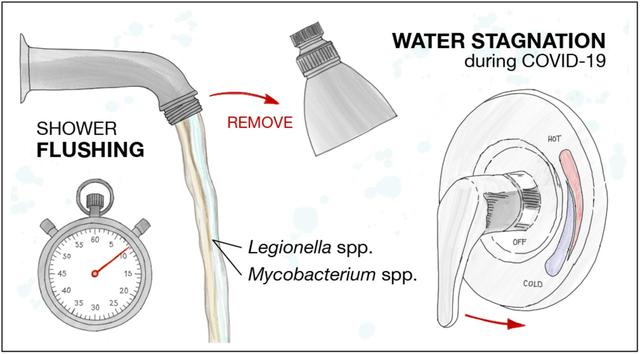As if fears about the coronavirus weren’t stressful enough for returning college students and faculty, Raymond Hozalski and Timothy LaPara had another worry: that a potentially deadly bacteria could be lurking in the water at campus buildings that were shuttered during the pandemic.
This spring, as COVID-19 sent people across the University of Minnesota to work and learn from home, the two professors launched a study to look for the presence of Legionella bacteria in the water supplies of buildings on the university’s Minneapolis and St. Paul campuses.
They thought it might be possible that the unprecedented closing of buildings could create ideal conditions for the opportunistic Legionella pathogens to thrive.
Legionella is a type of bacteria found naturally in lakes and streams. But it can pose a health concern when it grows in human-made water systems, including cooling towers, shower heads and hot tubs.
A strain of the bacteria, Legionella pneumophila, can cause a serious lung infection known as Legionnaires’ disease, which creates pneumonia-like symptoms. People can get Legionnaires’ disease when they inhale small droplets of water in the air that contain the bacteria.
About one in 10 people who get Legionnaires’ will die from the infection, according to the U.S. Centers for Disease Control and Prevention.
What Hozalski and LaPara found was surprisingly good news: While other types of Legionella bacteria were widespread, they detected no traces of Legionella pneumophila.
“We found actually less problems, honestly, than we thought,” Hozalski said.
The pair, colleagues in the University of Minnesota’s Department of Civil, Environmental and Geo-Engineering, tested water from showers in five university buildings that had been unused for more than two months due to closures caused by the COVID-19 pandemic, such as recreational centers. They sampled the water before and after flushing hot and cold water through the system.
Their theory was that the water sitting in the pipes of the closed buildings would likely reach a temperature suitable for the bacteria to grow, Hozalski said. The researchers also knew that chlorine, a chemical that most cities use to kill disease-causing pathogens in their water supplies, dissipates over time.
Using two different methods, including extracting DNA from the samples, Hozalski and LaPara said they did not detect any of the “worst-case scenario” bacteria they feared they would find.
“We did find Legionella quite frequently,” Hozalski said. “And there’s some evidence to suggest that all Legionella are human pathogens.” But if they’re not Legionella pneumophila, they’re generally considered to carry a lower risk of causing disease, he said.

The researchers did find that another bacteria, called mycobacteria, were widespread in the water samples. Mycobacteria generally don’t cause problems in healthy people, but can pose some risk for people with compromised immune systems, such as those with AIDS.
Hozalski and LaPara also sampled water at a high school and a youth camp outside the Twin Cities. Both of the sites draw their drinking supplies from groundwater. They did not find Legionella pneumophila there, either.
The researchers have some theories about why they didn’t find the deadly species they anticipated.
First is the timing of the pandemic: When the buildings were shut down this spring, the water was cold, so the Legionella may not have been very prevalent in the pipes, Hozalski said. Had the outbreak started in August or September, the results may have been different, he said.
Also, the cities of Minneapolis and St. Paul both draw their water from the Mississippi River. They use a mixture of chlorine and ammonia to kill pathogens, which tends to stick around and keep harmful organisms at bay, Hozalski said.
More concerning are water supplies that use pure chlorine — which doesn’t last as long as when it’s mixed with ammonia — or that draw groundwater from shallow wells and don’t use chlorine to disinfect, Hozalski said.
Hozalski and LaPara say their study size was too small to apply the results widely. But they do note that flushing the hot and cold water lines restored the chlorine levels and decreased the bacteria in the water within 30 minutes.
They offer some advice to people returning to a home, school or office after being away for an extended time, especially those with underlying health conditions: Run the taps to flush out the system and get rid of any unwanted intruders.
“Don’t leave it sit there for three months and then go take a shower right away,” LaPara said. He recommends turning on the exhaust fan and the hot and cold taps, and letting the water run for about 15 minutes, he said.
Also, keeping your water temperature set at at least 125 degrees Fahrenheit will help kill unwanted organisms, LaPara said.
The pair say the university buildings began a flushing routine after they began their study. The CDC has issued guidance for reopening buildings after a prolonged shutdown.
Hozalski and LaPara say they plan to submit their study for publication in the next week.
You make MPR News possible. Individual donations are behind the clarity in coverage from our reporters across the state, stories that connect us, and conversations that provide perspectives. Help ensure MPR remains a resource that brings Minnesotans together.
Donate today. A gift of $17 makes a difference.